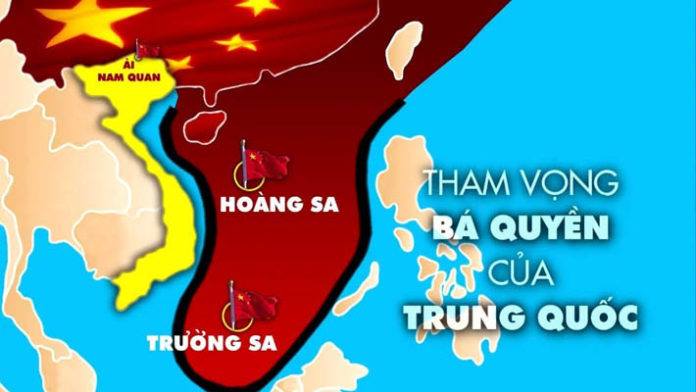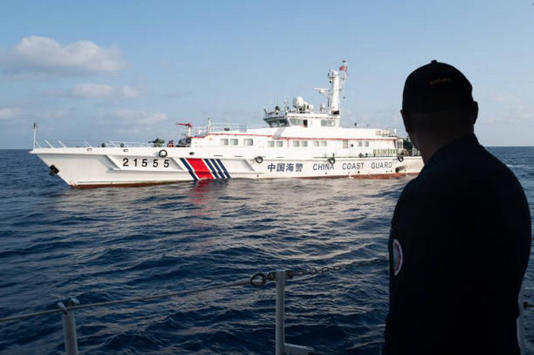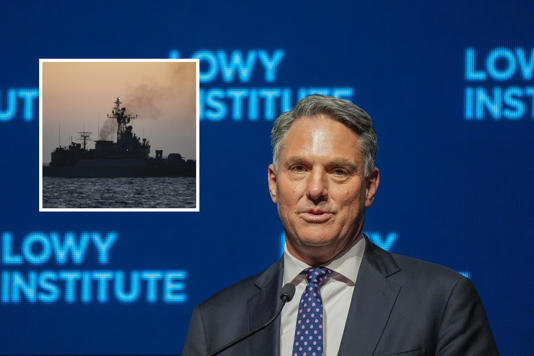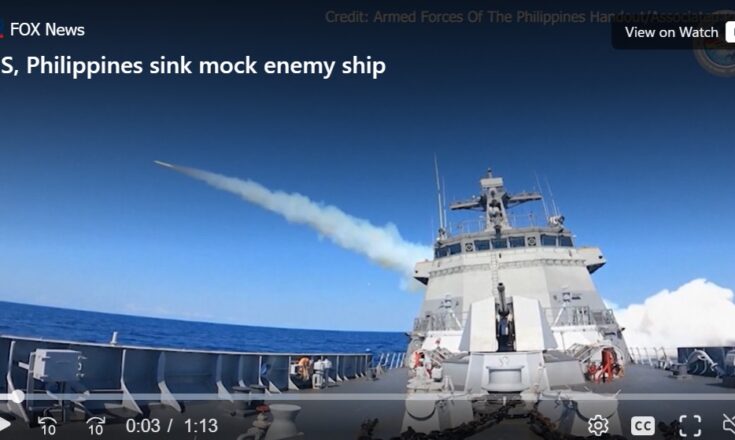
Tham vọng của Trung Quốc
Posted by Luu HoanPho, Jun 2, 2018, Comments Off
Trung Cộng hiện có khả năng kiểm soát nhiều đảo trên Biển Đông
Trung Cộng đã bố trí nhiều hệ thống tấn công và xây dựng các căn cứ quân sự trên nhiều hòn đảo đang tranh chấp chủ quyền thuộc hải phận Biển Đông. Đô đốc, Philip Davidson, người sắp trở thành Tư lệnh trưởng Bộ tư lệnh Thái Bình Dương Hoa Kỳ (PACOM) cho biết, Trung Cộng có khả năng kiểm soát đường biển khu vực này.
Trong một tuyên bố trước Uỷ ban Quân vụ Thượng viện tuần này, ông nói, quân đội Hoa Kỳ cần nhanh chóng chế tạo các loại vũ khí siêu thanh và các loại vũ khí hiện đại khác để đánh bại Trung Cộng nếu có xung đột xảy ra. “Trong tương lai, vũ khí siêu thanh, vũ khí sử dụng các nguồn năng lượng trực tiếp, không gian đàn hồi, mạng và năng lực xử lý mạng, binh lính đã được huấn luyện, thuỷ thủ, phi công, thuỷ quân lục chiến, lính gác biển sẽ rất quan trọng đối với khả năng chiến đấu giành chiến thắng của chúng ta.”
Davidson cho biết, Trung Quốc đã tiến hành quân sự hoá, xây dựng các căn cứ bắt đầu từ hồi tháng 12 năm 2013 tại đảo Gạc Ma thuộc quần đảo Trường Sa. Tính từ đó đến nay, Trung Cộng đã cải tạo, bồi đắp, mở rộng thêm đất trên đảo Gạc Ma và biến 6 rạn san hô khác thành đảo. Quân Giải phóng Nhân dân Trung Cộng (PLA) đã xây dựng một hệ thống radar đa chức năng, có thể tấn công và phòng thủ trên quần đảo Spratly bao gồm nhiều rạn san hô như Cuarteron Reef, Fiery Cross Reef, Gaven Reef, Hughes Reef, Johnson Reef, Mischief Reef và Subi Reef. Những cơ sở này là một thách thức lớn cho các hoạt động quân sự Hoa Kỳ tại vùng biển.
Các căn cứ trên bảy hòn đảo bao gồm nhiều nhà kho chứa máy bay, doanh trại, nhiên liệu ngầm, các thiết bị trữ nước, hầm chứa các hệ thống tấn công – phòng thủ. Những chiến dịch quân sự đi ngược với cam kết của Tập Cận Bình, năm 2015 tại Rose Garden, Tập Cận Bình đã khẳng định, Bắc Kinh không có ý định quân sự hoá Biển Đông. Ước tính Trung Cộng chi 5,3 nghìn tỷ cho hoạt động vận tải đường thuỷ hàng năm. Hiện tại, các cơ sở này đã gần được hoàn thành, duy chỉ chưa triển khai quân đội.
Các hòn đảo bị chiếm đóng cho phép Trung Cộng mở rộng ảnh hưởng hàng ngàn miles về phía nam và tăng cường sức mạnh trên Biển. PLA có thể sẽ sử dụng các căn cứ này, thách thức sự hiện diện của Hoa Kỳ trong khu vực, cũng như dễ dàng áp đảo bất kỳ lực lượng nào tiếp cận các hòn đảo. Tóm lại Trung Cộng giờ đây đã có khả năng kiểm soát Biển Đông.
Họ tiếp tục gửi chiến đấu cơ, và tàu đến gần quần đảo Senkaku Nhật Bản và tuyên bố chủ quyền. Quan hệ Trung Cộng và Đài Loan cũng trở nên tồi tệ và căng thẳng hơn.
Đô đốc Davidson nhận định, hiện đại hoá quân sự của Trung Cộng là kế hoạch tham vọng nhất thế giới, ông cảnh báo đó là mối đe doạ lớn đối với Hoa Kỳ. Tàu ngầm Trung Cộng mặc dù vẫn tụt hậu so với Hoa Kỳ, nhưng Trung Cộng đang có nhiều tiến bộ trong việc cải tiến tàu ngầm. Không quân Trung Cộng cũng phát triển các chiến đấu cơ tàng hình, máy bay ném bom tầm xa, máy bay không người lái.
Khả năng chiến tranh trên không gian mạng của Bắc Kinh rất đáng gờm, vượt xa khả năng thu thập thông tin tình báo, với kế hoạch tấn công vào bộ chỉ huy điều khiển quân sự Hoa Kỳ. Trung Cộng cũng vũ trang hoá vũ trụ với nhiều hoả tiễn, thiết bị gây nhiễu và laser có khả năng tiêu diệt các vệ tinh là công cụ chủ yếu của quân đội Hoa Kỳ.
Davidson cho biết, nếu được bổ nhiệm làm chỉ huy Bộ tư lệnh Thái Bình Dương, ông sẽ tiến hành xây dựng các lực lượng hải quân, quân đội, không quân trong khu vực đối đầu với các mối đe doạ ngày càng gia tăng của Trung Cộng ngoài hiểm hoạ Bắc Hàn.
Lực lượng hải quân hiện tại không đủ đáp ứng nhu cầu của Bộ Tư Lệnh Thái Bình Dương. Để đối phó với Trung Cộng Hoa Kỳ cần đầu tư, phát triển nhiều hơn vào những vũ khí thế hệ tiếp theo, như công nghệ siêu âm, đồng thời chấp nhận Trung Cộng đã có vũ khí không gian và mạng.
Đô đốc Harry Harris, Tư lệnh Bộ Chỉ huy Thái Bình Dương đã yêu cầu Ngũ Giác Đài ưu tiên phát triển vũ khí siêu âm trong chương trình Tấn công nhanh chóng bằng vũ khí thông thường của quân đội. Davidson cho biết, ông sẽ tiếp tục phát triển hoả tiễn siêu âm Hoa Kỳ để đối đầu với Trung Cộng.
Hôm thứ 4, không quân đã trao Lockheed Martin một hợp đồng trị giá 928 triệu dollar để phát triển vũ khí tấn công siêu âm trong bối cảnh Trung Cộng đã tiến hành thử nghiệm vũ khí siêu âm, hypersonic glide vehicle, có vận tốc hơn 7.000 miles một giờ. Với vận tốc này, hoả tiển siêu thanh có thể vượt qua các hệ thống phát hiện, phòng thủ hoả tiễn.
Nga cũng đang phát triển các hoả tiễn siêu âm. Rick Fisher, chuyên gia quân sự cao cấp tại Trung tâm Đánh giá Chiến lược Quốc tế cho biết, đánh giá của Đô đốc Davidson giúp Hoa Kỳ nhận ra Trung Cộng đang cố định hình thế giới theo mô hình độc tài của nó. Đô đốc Davidson cần nhanh chóng được phê chuẩn vì vai trò rất quan trọng của ông trong PACOM.
Để đối phó với hai hoả tiễn tầm trung mới của Trung Cộng, Hoa Kỳ cần phát triển các hoả tiển tương tự hiện đang bị cấm bởi “Hiệp ước hoả tiễn tầm trung” giữa Nga và Hoa Kỳ. Trung Cộng đang tiếp tục cải tiến hoả tiễn đạo đạo DF-21 và DF-26. Đồng thời Trung Cộng cũng đang theo đuổi các chương trình vũ khí hiện đại như hoả tiễn siêu âm. Các vũ khí tiên tiến này có khả năng đánh bại lực lượng Hoa Kỳ trong khu vực Ấn Độ – Thái Bình Dương.
Davidson cho biết, ông ủng hộ phát triển loại hoả tiễn bị Hiệp ước hoả tiễn tầm trung cấm. Ông nói, “Tôi tin rằng hiệp ước này không công bằng, đặt Hoa Kỳ vào thế bất lợi vì Trung Quốc không phải là một bên của Hiệp ước.” Davidson kêu gọi Hoa Kỳ huỷ bỏ hiệp ước, tuy nhiên có nhiều khả năng bị phản đối bởi những người muốn Hoa Kỳ dùng hiệp ước để kiềm toả Moscow.
Một nghiên cứu gần đây của Rand Corp cảnh báo Hoa Kỳ có khả năng thua trong một cuộc chiến với Trung Cộng. Davidson cho biết, ông thực sự quan tâm về cuộc xung đột trung tương lai. Ông nói, “Trung Cộng đã hiện đại hoá quân sự nhanh chóng trong 3 thập niên qua, không có gì bảo đảm Hoa Kỳ sẽ giành chiến thắng trong một cuộc xung đột với Trung Cộng. Để tăng cường khả năng chiến đấu của Hoa Kỳ tại Châu Á, quân đội Hoa Kỳ nên nhanh chóng phát triển các loại vũ khí hiện đại, duy trì và mở rộng kết nối các liên minh trong khu vực.” Các lĩnh vực cần phát triển bao gồm, khả năng chiến đấu dưới biển, kho đạn dược, hoả tiển đứng như hoả tiễn không đối không, không đối đất, đất đối đất, hoả tiễn chống hạm. Ngoài ra, các hoả tiễn hành trình tầm trung, hệ thống phòng thủ hoả tiễn, vũ khí siêu âm, khả năng mạng, tiếp liệu, thông tin liên lạc, điều hướng cũng rất cần thiết.
Davidson cho biết, Trung Cộng đang sử dụng sáng kiến vành đai Thái Bình Dương để thúc đẩy, mở rộng hệ thống chống dân chủ phù hợp với mô hình độc tài của riêng mình. Ông nói “Tôi tin rằng bản chất bóc lột của sáng kiến này nhằm dùng để ép các quốc gia gia tăng ảnh hưởng của Trung Cộng.”
[-UPN Tin Dịch 30/04/2018]
———————————
Pacom Nominee: China Military Islands Now Control South China Sea
China has deployed electronic attack systems and other military facilities on disputed islands in the South China Sea and is now capable of controlling the strategic waterway, according to the admiral slated to be the next Pacific Command chief.
Additionally, the command nominee Adm. Philip Davidson told the Senate Armed Services Committee in a written statement this week that the military urgently needs hypersonic and other advanced weaponry to defeat China’s People’s Liberation Army in a future conflict.
“In the future, hypersonic and directed energy weapons, resilient space, cyber and network-capabilities, and well-trained soldiers, sailors, airmen, marines, and coastguardsmen will be crucial to our ability to fight and win,” the four-star admiral said in written answers to questions from the Senate Armed Services Committee.
On China’s militarization and take over of the South China Sea, Davidson said the buildup of forward military bases began in December 2013 at Johnson Reef in the Spratly islands. Since then, the Chinese have fortified that reef and six others with military facilities, Davidson said.
“In the South China Sea, the PLA has constructed a variety of radar, electronic attack, and defense capabilities on the disputed Spratly Islands, to include: Cuarteron Reef, Fiery Cross Reef, Gaven Reef, Hughes Reef, Johnson Reef, Mischief Reef and Subi Reef,” Davidson said.
“These facilities significantly expand the real-time domain awareness, [intelligence, surveillance reconnaissance], and jamming capabilities of the PLA over a large portion of the South China Sea, presenting a substantial challenge to U.S. military operations in this region,” he added.
The bases on the seven islands include hangars, barracks, underground fuel and water storage facilities, and bunkers for “offense and defensive kinetic and non-kinetic systems,” he states.
The militarization contradicts a promise from Chinese supreme leader Xi Jinping not to militarize the South China Sea that is used as a waterway transit for an estimated $5.3 trillion in goods annually.
“These actions stand in direct contrast to the assertion that President Xi made in 2015 in the Rose Garden when he commented that Beijing had no intent to militarize the South China Sea,” Davidson said.
“Today these forward operating bases appear complete. The only thing lacking are the deployed forces.”
The occupied islands will permit China to extend its influence thousands of miles southward and project power deep into the Oceania.
“The PLA will be able to use these bases to challenge U.S. presence in the region, and any forces deployed to the islands would easily overwhelm the military forces of any other South China Sea-claimants,” Davidson said. “In short, China is now capable of controlling the South China Sea in all scenarios short of war with the United States.”
In the East China Sea, China continues to send aircraft and ships to waters near Japan’s Senkaku Islands, which China is claiming as its islands. The Chinese have continued a steady level of activity that reflects “China’s intent to coerce Japan without sparking a crisis or conflict,” Davidson said.
China’s relations with the democratic ruled island of Taiwan remain tense and any improvement in relations was described by Davidson as dim.
The statements revealed new details about China’s military buildup and regional expansion the prepared answers to policy questions.
The admiral described the Chinese military buildup as “the most ambitious military modernization in the world,” and warned “the threat to U.S. forces and bases is substantial and growing.”
China’s submarine forces still lag behind those of the United States but China is making progress in developing quieter submarines. Its air forces are also growing in sophistication with advanced stealth fighters, long-range bombers and advanced unmanned aircraft.
Beijing’s cyber warfare capabilities are significant and go well beyond intelligence-gathering with plans for attacks on military command and control networks, he said.
China also is weaponizing space with missiles, jammers, and lasers capable of killing satellites, key American military power projection tools.
The four-star admiral said if confirmed to lead the Pacific Command, he will carry out a buildup of Navy, Army, and Air Force forces in the region to confront the growing threat posed by China, in addition to continuing dangers from North Korea.
Current naval forces are insufficient in backing Pacific Command’s needs, he said.
To deal with China, “the United States should expand the competitive space by investing in next-generation capabilities (e.g., hypersonic technology) while simultaneously recognizing that China is already weaponizing space and cyber,” Davidson stated.
Outgoing Pacific Command commander, Adm. Harry Harris, has requested priority Pentagon development of a U.S. hypersonic weapon, part of the military conventional prompt strike program.
Davidson said he would continue to support a U.S. hypersonic missile to deal with China.
“I view the long-range, hypersonic weapon capability that Conventional Prompt Strike would provide as essential to our ability to compete, deter, and win against a strategic competitor such as China,” he said.
On Wednesday, the Air Force announced the award of a $928 million contract to Lockheed Martin for a hypersonic strike weapon.
China has conducted seven tests of a hypersonic glide vehicle fired atop a ballistic missile that travels and maneuvers at speeds of 7,000 miles per hour or greater. The high speeds and maneuverability make the missiles very difficult to target and counter with missile defenses.
Russia also is developing hypersonic missiles.
Rick Fisher, a senior fellow at the International Assessment and Strategy Center, said the admiral’s comments provide a great service in helping Americans recognize that China is working to shape the world according to its authoritarian model.
“Effective leadership can only emerge from such essential recognition of the facts,” Fisher said. “On this basis, the Admiral deserves rapid confirmation as he is very much needed in PACOM.”
In response to China’s two new medium- and intermediate-range anti-ship missiles, the United States needs to build similar missiles currently banned under the U.S.-Russian Intermediate-range Nuclear Forces (INF) treaty, Davidson stated.
“China continues to improve its ballistic missile capabilities, with the DF-21 and DF-26 missiles offering improved range, accuracy, lethality, and reliability over legacy Chinese systems,” he said.
“Simultaneously, China is pursuing advanced capabilities (e.g., hypersonic missiles) which the United States has no current defense against,” he said.
The advanced weapons place U.S. forces across the Indo-Pacific increasingly at risk.
Davidson said he favors building missiles banned under INF, a treaty violated by Moscow through the deployment of a new ground-launched cruise missile.
Additional missiles are needed beyond the plan for Conventional Prompt Strike weapons.
“In the Indo-Pacific, the absence of the INF Treaty would provide additional options to counter China’s existing missile capabilities, complicate adversary decision making, and impose costs by forcing adversaries to spend money on expensive missile defense systems,” the admiral said.
“I believe the INF treaty today unfairly puts the United States at a disadvantage and places our forces at risk because China is not a signatory.”
The comments by Davidson urging the United States to jettison the INF treaty likely will be opposed by arms control advocates who want the United States to remain limited by the treaty in the hope Moscow could return to compliance.
On China’s nuclear buildup, Davidson said the expansion of nuclear forces does not appear to indicate Beijing is abandoning its policy of not being the first to use nuclear arms in a conflict.
“China has developed or is developing advanced/precision [intermediate-range ballistic missiles] and [medium-range ballistic missile] systems,” he said. “These systems could support a variety of nuclear strike options, tactical-to-strategic and preemptive-to-retaliatory. However, they are not-themselves-indicative of any shift in China’s no first use policy.”
In response to a recent Rand Corp. study that warned the United States risks losing a war with China, Davidson said he has “increasing concerns” about a future conflict.
“China has undergone a rapid military modernization over the last three decades and is approaching parity in a number of critical areas; there is no guarantee that the United States would win a future conflict with China,” he said, noting U.S. advantages in personnel, training, and joint warfighting.
To bolster U.S. warfighting capabilities in Asia, the U.S. military should rapidly develop “high-end” weapons, preserve regional alliances, and continue to recruit high-quality people.
Davidson said critical investments are needed in several areas, including undersea warfare, added munitions stockpiles, standoff missiles, including air-to-air, air-to-surface, surface-to-surface, and anti-ship missile.
Also needed are intermediate-range cruise missiles, low cost/high capacity cruise missile defenses, hypersonic weapons, air and surface transport systems, cyber capabilities, air-air refueling capacity, and resilient communication and navigation systems.
Priorities for the Asia-Pacific weapons buildup are increasing stockpiles of precision guided munitions, submarine warfare systems, counter-missile systems, and more intelligence and surveillance systems.
Reflecting the Trump administration’s strategic policies that identify China as a threat, Davidson said China is using its development initiative called Belt and Road to advance anti-democratic expansion.
“It is increasingly clear that China wants to shape a world aligned with its own authoritarian model,” he said.
“The predatory nature of many of the loans and initiatives associated with the Belt and Road Initiative (BRI) lead me to believe that Beijing is using BRI as a mechanism to coerce states into greater access and influence for China.”





